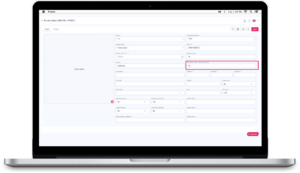Batch and expiration monitoring: How to properly manage the storage of products with limited expiration?


Proper management of batches and expiration dates is key for the storage of products with a limited durability. Goods from the food, cosmetics or pharmaceuticals segments are subject to strict regulations where improper handling can result in unnecessary losses, unsaleable stock or even product recalls.
What are batch and expiration dates, how do FIFO and FEFO inventory management methods relate to them, and how to track expiration dates? Read more in our article. In addition, we will conclude with an overview of how we work with expirations in Skladon.
What is a batch and why is it important to monitor it?
A lot acts as a record number for a group of products that have been produced under the same conditions and often within the same production cycle. Products with the same lot number have the same composition, production line, production date and expiration date.
Effective batch management helps to minimise risks while ensuring compliance with legislative requirements. Proper batch record keeping enables:
- rapid recall of defective products – when problem products are discovered, the specific batch can be traced and removed, minimising damage and protecting end consumers;
- compliance with legislation – due to strict quality standards, batch monitoring is mandatory in the pharmaceutical and food sectors within the European Union;
- quality assurance of production – batch monitoring helps to identify production errors and optimise production processes;
- increase warehouse efficiency – accurate record keeping facilitates the use of FIFO (First In, First Out) and FEFO (First Expired, First Out) methods to prevent out-of-date goods.
Batches are most commonly used in the following industries:
- food industry – monitoring freshness, quality assurance and product safety;
- pharmaceuticals – control of pharmaceuticals and traceability of defective batches;
- cosmetics – monitoring composition and regulation for user safety;
- automotive and industrial – monitoring of manufacturing processes, materials and components.
Batch records
Basic batch recording is done manually in many companies, for example by recording in spreadsheets or simple internal systems. This approach is time-consuming and error-prone, especially in warehouses with fast turnaround or a wide range of products and product variants. The batch is not only recorded in the systems but also printed directly on the product or its packaging.
A more efficient approach is advanced automated record keeping, which allows information to be linked directly to the stock movement and therefore batch monitoring in real time. For these purposes, the following are mainly used:
- barcodes – e.g. EAN or GS1-128, which contain batch number, date of manufacture or expiration date – the advantage is easy scanning during goods receipt or dispatch;
- QR codes – fast retrieval of information and connection to digital databases;
- RFID technology – unique chips that wirelessly identify products without the need for direct scanning.
Note: By linking barcoding with the WMS system, it is possible to significantly speed up receiving, storage and dispatching and at the same time achieve almost 100% accuracy in batch registration.
Expiration and inventory management methods FIFO vs. FEFO
In addition to monitoring batches, it is also essential to monitor the expiration date for products with a limited durability. The expiration date determines the expiry date, i.e. the shelf life or effectiveness of the product, and sets the limit until which the product is suitable for use and sale. Underestimating expiration date control can lead to stock devaluation, financial loss or, in worse cases, end-customer health risks.
To avoid these risks, logistics uses proven inventory management methods: FIFO and FEFO.
FIFO (First In, First Out)
The FIFO method works on the principle that the products that have been loaded into the warehouse first are removed first.
- Suitable for common products without a fixed expiration date.
- Helps to naturally rotate inventory and prevent the accumulation of “lagers” – products that are stored for long periods of time, therefore financially inefficient.
- Easy to implement even in warehouses with simpler WMS systems.
Note: You can read more about the FIFO method in our article “E-commerce logistics: What is FIFO and how to work with it“.
FEFO (First Expired, First Out)
FEFO is a method that prioritizes the items with the closest expiration dates – those that need to be picked first.
- Key in industries such as food, pharmaceuticals, cosmetics and dietary supplements.
- Ensures that a product with a long enough durability always reaches the customer.
- Requires accurate expiration monitoring and the support of a more advanced WMS system.
For example: In Skladon we can set up warehouse processes so that goods are automatically picked according to the selected method – FIFO or FEFO. The result is efficient inventory management, lower risk of losses and maximum customer satisfaction.
Automated expiration monitoring systems
Fulfilment centers are increasingly using automated systems that simplify the entire expiration monitoring process. The basis for automation are the aforementioned WMS systems, which not only allow the registration of expiration dates, but also the automatic assignment of a picking method (e.g. FEFO) or blocking of goods with an expired date.
In addition, WMS systems provide real-time visibility of inventory levels, including expiration data and detailed traceability down to the batch level.
Automatic alerts for approaching expiration dates
A huge advantage is the ability to set up automatic notifications at the product level for upcoming expirations. Thanks to them, you can react in time – for example, discount the product, redirect it to another sales channel, put it on sale or withdraw it from sale.
TIP: In Skladon, we allow you to set up these notifications within the MySkladon client application. In the inventory, the user can individually set an expiration date for each product in the “Expiration notice – days in advance” field, which will then be used to notify the user by email that the product is nearing its expiration date.

The future of inventory management
Some advanced systems can already work with artificial intelligence or various analyses for even more efficient inventory management. These tools make it possible to:
- predict optimal stock levels based on seasonality or historical data;
- identify products at higher risk of expiration before they are stocked;
- recommend methods for picking and optimizing turnover.
The future is not just about controlling data, but also about proactive planning and smart decision-making based on available information and parameters.
Skladon: Batches and expiration dates under control
At Skladon, we believe that effective batch and expiration management is the cornerstone of quality fulfillment – especially for clients in the aforementioned areas. That’s why every relevant product goes through our batch and expiration date monitoring system when it arrives at our warehouse.
Using our WMS system, we ensure accurate record keeping and traceability of goods down to the individual SKU level, allowing us to automatically manage storage methods (FIFO/FEFO) according to the specific needs of each product. In addition, as mentioned earlier, our clients can set how many days in advance the system should notify them of impending expiry within MySkladon, ensuring full control over stock durability.
